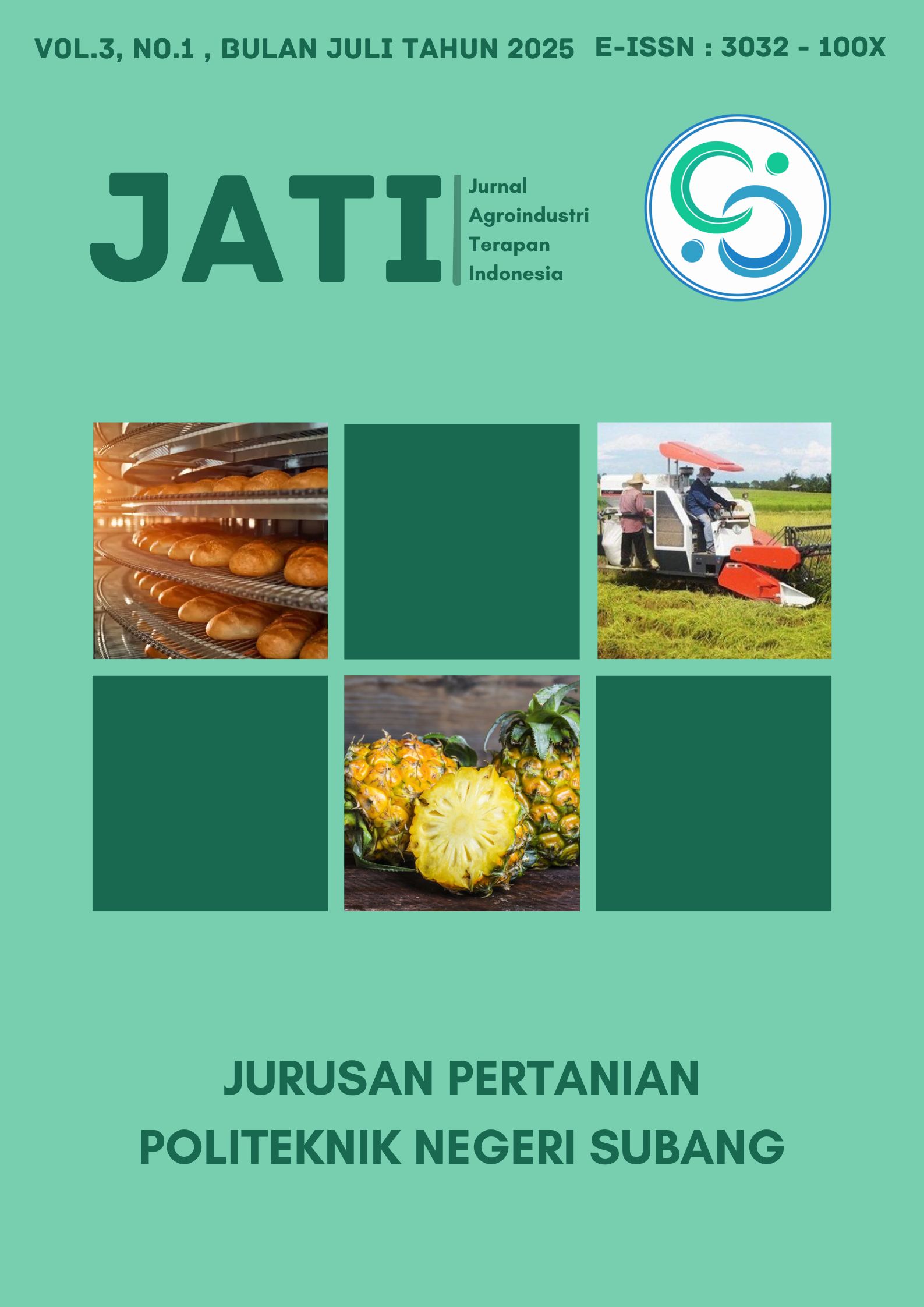SIFAT TANAK PLASMA NUTFAH PADI VARIETAS LOKAL: SENTANI, CAKRA, CIHERANG BATU, DAN KETAN DI GAPOKTAN KALENG BANTENG Cooking Traits of Rice Germplasm from Local Rice Varieties: Sentani, Cakra, Ciherang Batu, and Ketan in GAPOKTAN Kaleng Banteng
Main Article Content
Abstract
Pre-breeding of local rice is one of the important efforts to improve the quality of rice. Local rice has a source of genetic diversity that can be utilized to assemble new superior varieties and has the advantage of biotic and abiotic stress tolerance. Gapoktan Kaleng Banteng is a Farmer Group Association around the Kaleng Banteng Block area, Cibogo, Subang. Gapoktan Kaleng Banteng grows local rice varieties such as Sentani, Cakra, Ciherang Batu, and Ketan. Exploration of rice cooking traits is related to the improvement of rice quality in plant breeding activities. The purpose of this study was to identify the cooking traits of four local rice varieties at the genotype level. The method used was Iodine Staining of pollen. The genetic material used in this study was rice pollen from local rice varieties Sentani, Cakra, Ciherang Batu, and Ketan. Cooking traits at the genotype level can be categorized into waxy, heterowaxy, and nonwaxy. Rice pollen that produces a blue-black color is nonwaxy. Rice pollen that produces orange or brick red color is waxy. While rice pollen that produces both colors is heterowaxy. The cooking traits of local rice varieties in Gapoktan Kaleng Banteng have diversity. The diversity of cooking traits at the genotype level through the Iodine Staining method of pollen produces two colors, namely blue-black and orange. The characteristics of local varieties of Sentani, Cakra, and Ciherang Batu are categorized as nonwaxy. The characteristics of Ketan varieties categorized as heterowaxy.
Article Details

This work is licensed under a Creative Commons Attribution-NonCommercial-ShareAlike 4.0 International License.
References
Anisa, S., Dalimunthe, G. I., Lubis, M. S., & Yuniarti, R. (2023). Berpotensi sebagai film coated pada tablet. Jurnal Farmasi, Sains, Kesehatan. 3(1).
Ezward, C., Suliansyah, I., Rozen, N., & Dwipa, I. (2024). Eksplorasi keragaman plasma nutfah padi lokal kuantan singingi berdasarkan morfologi gabah dan beras. Jurnal Agroteknologi, 15(1). doi: 10.24014/ja.v15i1.23429
Faizah, I. N., Tamrin, T., Rahmawati, W., & Suharyatun, S. (2024). Analisis kebutuhan air untuk penanakan nasi dengan berbagai jenis beras. Jurnal Agricultural Biosystem Engineering, 3(2), 248. https://doi.org/10.23960/jabe.v3i2.9538.
Firdaus, I. A., Kitashiba, H., Tetsuo, T., Khumaida, N., & Ardie, S. W. (2020). Novel nonwaxy allele variation among foxtail millet genotypes from indonesia. SABRAO J. Breed. Genet.
Kelana, H. W., Hidayat, T., & Widodo, A. (2016). Pewarisan Pengetahuan dan Keterampilan Identifikasi Keanekaragaman Tanaman Padi Lokal pada Generasi Muda Kasepuhan Adat Banten Kidul. 13.
Lestari, P., & Susanto, U. (2021). Pemuliaan Tanaman Berbasis Teknologi Frontier dan Preferensi Konsumen. Jakarta (ID): IAARD Press.
Marlina, G., Andriani, D., Jayalaksamana, M., & Pramana, A. (2023). Potential diversity of local rice genetic resources in Kuantan Singingi District, Riau Province. Jurnal Pangan, 32(2), 103–110. https://doi.org/10.33964/jp.v32i2.635.
Pedersen, J. F., Bean, S. R., Funnell, D. L., & Graybosch, R. A. (2004). Rapid iodine staining techniques for identifying the waxy phenotype in sorghum grain and waxy genotype in sorghum pollen. Crop Science, 44(3), 764–767. https://doi.org/10.2135/cropsci2004.7640.
Pusat Data dan Sistem Informasi Pertanian. (2023). Statistik Pertanian (Agriculture Statistics). Jakarta (ID): Kementerian Pertanian.
Slamet, W. Y., Wardani, A. R. S., Sari, S., & Carsono, N. (2018). Seleksi karakter kandungan amilosa sedang pada populasi hasil persilangan Sintanur x PTB33 dan Pandanwangi x PTB33 berdasarkan Marka Fenotipik dan Molekuler SSR. Kultivasi, 17(3). https://doi.org/10.24198/kultivasi.v17i3.18508.
Suroya, L. F., Wirnas, D., Trikoesoemaningtyas, T., & Reflinur, R. (2023). Identification of waxy genotype in sorghum genetic resources using waxy gene-based markers and iodine staining methods. Australian Journal of Crop Science, 17(02):2023, 190–197. https://doi.org/10.21475/ajcs.23.17.02.p3784.
